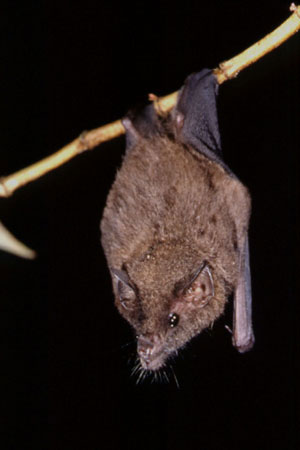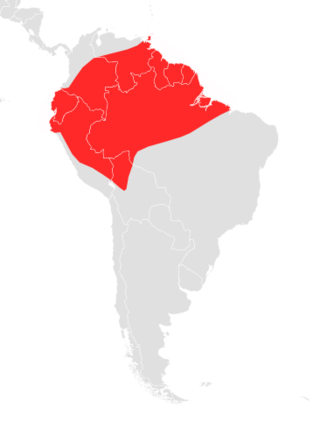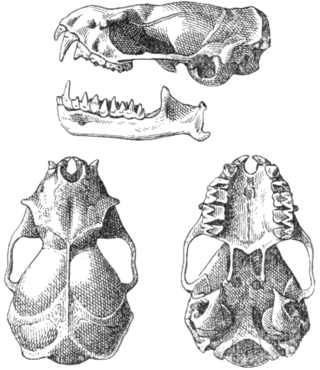
The New World leaf-nosed bats (Phyllostomidae) are found from southern North America to South America, specifically from the Southwest United States to northern Argentina. They are ecologically the most varied and diverse family within the order Chiroptera. Most species are insectivorous, but the phyllostomid bats include within their number true predatory species and frugivores. For example, the spectral bat, the largest bat in the Americas, eats vertebrate prey, including small, dove-sized birds. Members of this family have evolved to use food groups such as fruit, nectar, pollen, insects, frogs, other bats, and small vertebrates, and in the case of the vampire bats, even blood.

The spectral bat, also called the great false vampire bat, great spectral bat, American false vampire bat or Linnaeus's false vampire bat, is a large, carnivorous leaf-nosed bat found in Mexico, Central America, and South America. It is the only member of the genus Vampyrum; its closest living relative is the big-eared woolly bat. It is the largest bat species in the New World, as well as the largest carnivorous bat: its wingspan is 0.7–1.0 m (2.3–3.3 ft). It has a robust skull and teeth, with which it delivers a powerful bite to kill its prey. Birds are frequent prey items, though it may also consume rodents, insects, and other bats.

The big-eared woolly bat or (Peters's) woolly false vampire bat is a species of bat, belonging to the family Phyllostomidae.

Geoffroy's tailless bat is a species of phyllostomid bat from the American tropics.

The lesser long-tongued bat, also called the lesser long-tailed bat, is a bat species from South America.

The long-legged bat is a member of the Phyllostomidae family in the order Chiroptera. Both males and females of this species are generally small, with wingspans reaching 80mm with an average weight ranging between 6 and 9 grams. The facial structure of these bats includes a shortened rostrum with a prominent noseleaf. The most defining feature of these bats however, is their long posterior limbs that extend farther than most Phyllostomidae bats. At the ends of these hind legs, the long-legged bat has abnormally large feet equipped with strong claws.

The little big-eared bat is a bat species in the order Chiroptera and family Phyllostomidae. It is from South and Central America particularly Colombia, Venezuela, Guyana, French Guiana, Brazil, Peru, Ecuador, Bolivia, Argentina, Paraguay, Suriname and Trinidad. Though its exact population is unknown, it is considered widespread and occurs in protected areas, although deforestation may be a minor threat, it is classified as Least Concern. It is found in multistratal evergreen forests and dry thorn forests and forages near streams and is found hollow trees, logs, caverns, or houses with groups up to twelve. The head and body length measures at 44 millimetres (1.7 in) for males and 45 millimetres (1.8 in) for females. Males usually weigh about 5 grams (0.18 oz) while females weigh 5.7 grams (0.20 oz).

The little goblin bat is a species of bat in the family Molossidae, the free-tailed bats. It is endemic to Cuba.

The Cuban fruit-eating bat is a species of bat in the family Phyllostomidae found in the Cayman Islands, Cuba, and Hispaniola .It has been extirpated from the Bahamas and Jamaica.

The Mexican long-tongued bat is a species of bat in the family Phyllostomidae. It is the only species within the genus Choeronycteris. The species is found in El Salvador, Guatemala, Honduras, Mexico, and the United States.

The buffy flower bat is a species of bat in the leaf-nosed bat family, Phyllostomidae. It is found in the Bahamas, the Cayman Islands, Cuba, and Jamaica.

Waterhouse's leaf-nosed bat is a species of big-eared bat in the family Phyllostomidae. It is found in the Greater Antilles in the Cayman Islands, Cuba, Hispaniola and Jamaica, as well as Mexico south to Guatemala.

Leach's single leaf bat, also known as Greater Antillean long-tongued bat, is a species of bat in the family Phyllostomidae. It is found in the southern Bahamas and in all the Greater Antilles. It forms large colonies, with up to a few hundred thousand individuals, and feeds on a relatively wide variety of food items including pollen, nectar, fruit and insects.
Phyllonycteris is a genus of bat in the family Phyllostomidae. It contains the following species:

The Cuban fig-eating bat, or white-shouldered bat, is a species of bat in the family Phyllostomidae, found only in the Caribbean. It is the sole extant species in the genus Phyllops, although two other species, P. vetus and P. silvai, are known from fossils.

Macleay's mustached bat is a species of bat in the family Mormoopidae. It is found in Cuba and Jamaica, and is threatened by habitat loss. The species is named for William Sharp Macleay, who collected the type specimen.
The sooty mustached bat is a species of bat in the family Mormoopidae. It is found in throughout the Greater Antilles, in Cuba, Hispaniola, Jamaica, and Puerto Rico.

The Cuban greater funnel-eared bat is a species of funnel-eared bat. It is endemic to a cave in westernmost Cuba.

The brown flower bat is a species of bat from the family Phyllostomidae native to the island of Hispaniola, and Puerto Rico.


















